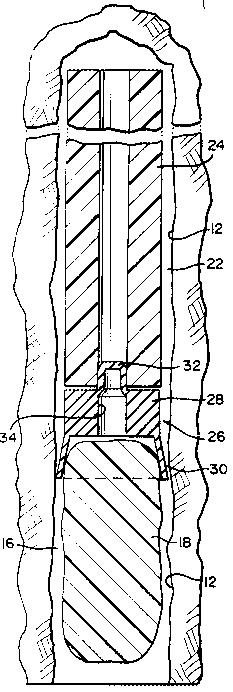Some of the information on this Web page has been provided by external sources. The Government of Canada is not responsible for the accuracy, reliability or currency of the information supplied by external sources. Users wishing to rely upon this information should consult directly with the source of the information. Content provided by external sources is not subject to official languages, privacy and accessibility requirements.
Any discrepancies in the text and image of the Claims and Abstract are due to differing posting times. Text of the Claims and Abstract are posted:
| (12) Patent: | (11) CA 2039664 |
|---|---|
| (54) English Title: | BARRIER PLUG FOR A BORE |
| (54) French Title: | CLAPET OBTURATEUR POUR SONDAGE |
| Status: | Expired and beyond the Period of Reversal |
| (51) International Patent Classification (IPC): |
|
|---|---|
| (72) Inventors : |
|
| (73) Owners : |
|
| (71) Applicants : |
|
| (74) Agent: | SWABEY OGILVY RENAULT |
| (74) Associate agent: | |
| (45) Issued: | 1995-12-12 |
| (22) Filed Date: | 1991-04-03 |
| (41) Open to Public Inspection: | 1991-10-20 |
| Examination requested: | 1991-04-03 |
| Availability of licence: | N/A |
| Dedicated to the Public: | N/A |
| (25) Language of filing: | English |
| Patent Cooperation Treaty (PCT): | No |
|---|
| (30) Application Priority Data: | ||||||
|---|---|---|---|---|---|---|
|
A barrier for use with a rod extending into a bore
having a cross sectional dimension, formed in a structure.
The barrier is located on one side of a fluid supply in the
bore. The barrier includes a sealing portion adjacent the
fluid supply, the sealing portion has a flexible flange in
sealing contact with the bore. A tube is connected to the
sealing portion and has a rod passageway formed there
through. A diameter of the tubular portion is smaller than
the cross sectional dimension prior to insertion of the rod,
and expands to conform to the cross sectional dimension in
response to insertion of the rod. A rupture portion is
connected to the tubular portion, and seals the rod
passageway to limit a passage of fluid therethrough prior to
insertion of the rod. The rupture portion is adapted to
rupture in response to penetration by the rod. The barrier
may be used in conjunction with a dynamic earth anchor, to
prevent passage of the grout to between the anchor and the
bore.
Note: Claims are shown in the official language in which they were submitted.
Note: Descriptions are shown in the official language in which they were submitted.

2024-08-01:As part of the Next Generation Patents (NGP) transition, the Canadian Patents Database (CPD) now contains a more detailed Event History, which replicates the Event Log of our new back-office solution.
Please note that "Inactive:" events refers to events no longer in use in our new back-office solution.
For a clearer understanding of the status of the application/patent presented on this page, the site Disclaimer , as well as the definitions for Patent , Event History , Maintenance Fee and Payment History should be consulted.
| Description | Date |
|---|---|
| Inactive: Adhoc Request Documented | 1997-04-03 |
| Time Limit for Reversal Expired | 1997-04-03 |
| Letter Sent | 1996-04-03 |
| Grant by Issuance | 1995-12-12 |
| Application Published (Open to Public Inspection) | 1991-10-20 |
| All Requirements for Examination Determined Compliant | 1991-04-03 |
| Request for Examination Requirements Determined Compliant | 1991-04-03 |
There is no abandonment history.
Note: Records showing the ownership history in alphabetical order.
| Current Owners on Record |
|---|
| INGERSOLL-RAND COMPANY |
| Past Owners on Record |
|---|
| CLIFFORD A. MCCARTNEY |
| ROGER GRBAVAC |